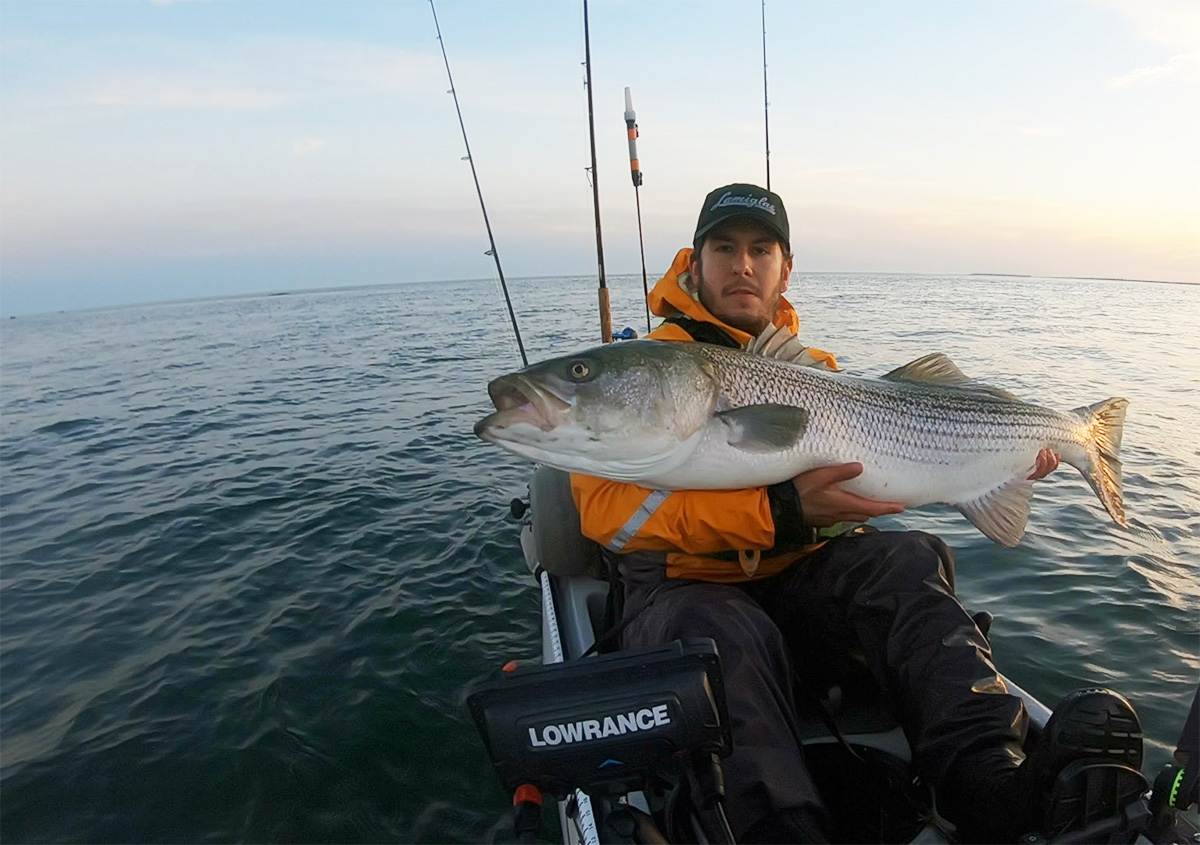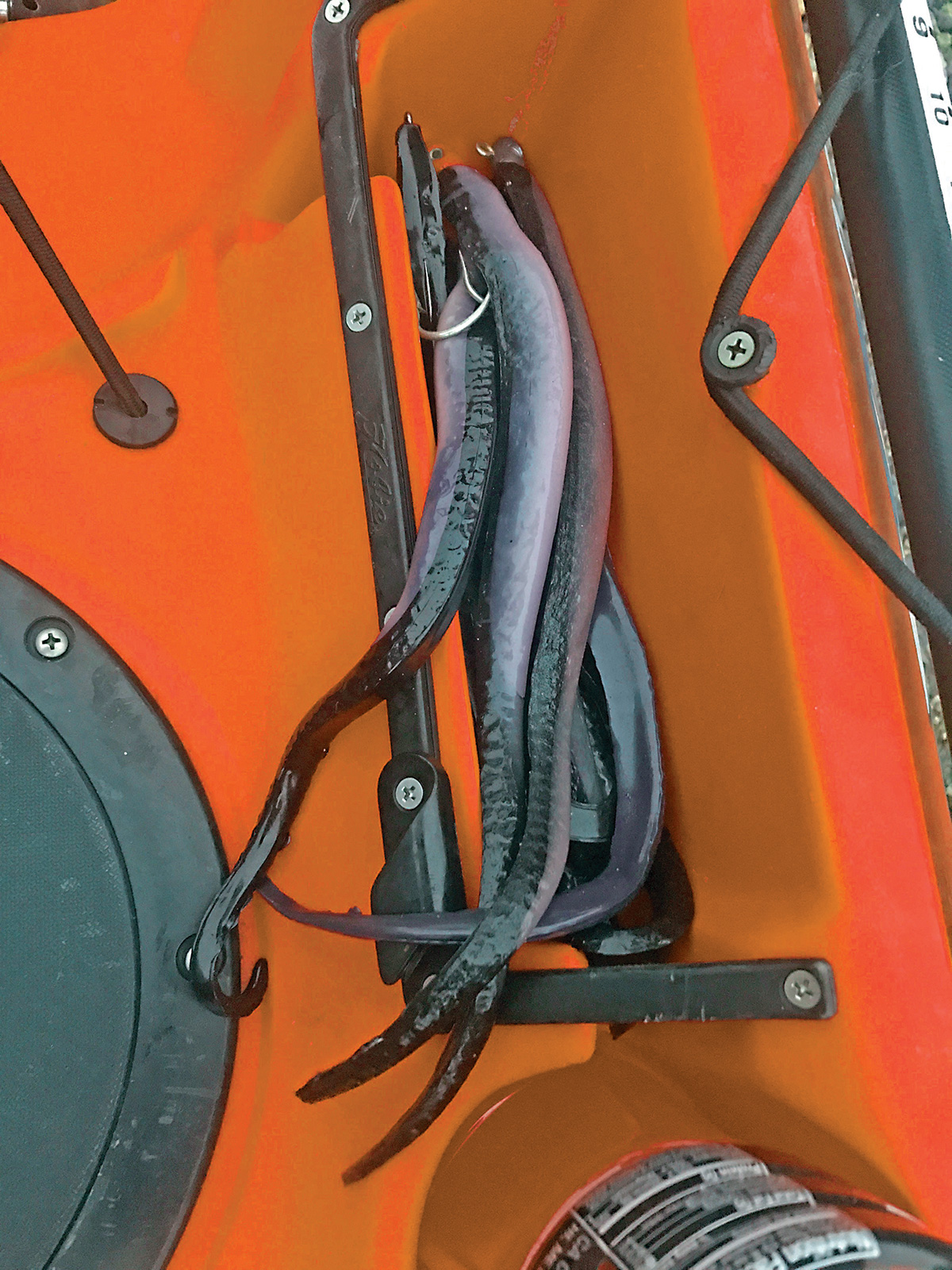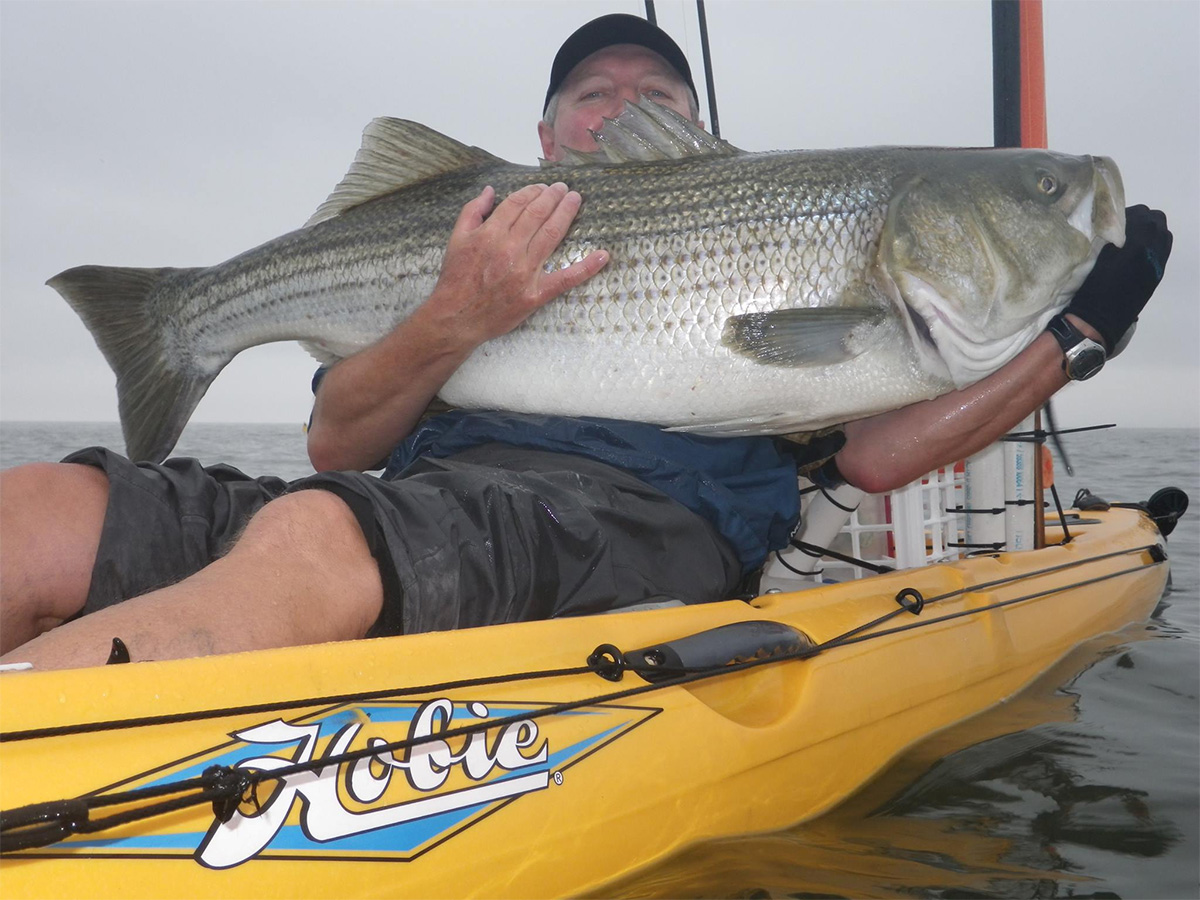
One of the most effective ways to target large striped bass from a kayak is with large, eel-shaped soft plastics rigged on jig heads. The late Mark Konarski was my biggest influence in learning this technique as he was a master of the craft. Mark would go out armed with nothing more than a handful of 14-inch rubber eels rigged on lead heads and some bucktails. Regularly, he would put on a clinic and out-fish those around him fishing live bait. Between witnessing Mark’s success first hand, and seeing all the huge striped bass that Eric “Slappy” Harrison has caught over the years on nothing more than “rubber worms,” I quickly became intrigued by the technique and set out to figure it out for myself. After a short learning curve the method has proven itself time and time again as my fishing partners and I have come to rely on the technique to boat countless huge striped bass over the last several seasons.
There are two ways I typically fish the soft plastics on jig heads. The first is simply to bounce bottom with the jig in a rip, and the second is swimming the jig through boulder fields with slower current. Each has its time and place in which it is most effective, and between the two applications one can cover almost all inshore scenarios.
Bouncing Jigs
Bottom bouncing a soft plastic is quite simple. I position my kayak so that my bow is facing into the current on top of a ledge or rocky structure. My Hobie pedal drive kayak helps with boat position, especially when bottom bouncing in a rip. I cast directly up current onto the structure and allow my jig to sink until it hits bottom. I then lift up slightly, take a few cranks on my reel, and allow the jig to fall back down once again until it hits bottom. I repeat this process until I get a hit or the jig is directly below my kayak. I make several casts before resetting back up-current.
Most of the fish hit on the drop just before the jig hits bottom, so being ready to make a quick hook-set is important. The concept is easy to grasp after you’ve done it a few times and have had some success, but keeping the jig from hanging up on the bottom tends to be an art form. A high-speed, low-profile baitcaster provides a real advantage for this since you have direct contact with the line and can recover several feet of line very quickly.

As with most jigging scenarios, I use the lightest jig I can get away with. I want just enough weight so that I reach the bottom quickly and stay in the strike zone, but I don’t constantly hang up. In my kayak crate there are always several baits rigged up on 3/4-, 1-, 1-1/2-, and 2-ounce jigs so that I can quickly change as conditions dictate. Most of the time I use 1- and 1-1/2-ounce heads, but I adjust accordingly as needed. If I’m not feeling the bottom enough, I go up in weight until I do. If it’s hanging up too much or dragging bottom, I go down in size until it no longer does.
Sometimes the bigger fish can be found on the bottom in open water a few hundred feet behind the structure taking advantage of a current break. Don’t be afraid to drift slightly down current if you do not immediately find fish tight to the main structure where you’d expect them to be.
Swimming Jigs
Swimming the jigs is most effective in slowly-moving water or shallower areas where you will otherwise hang up constantly. I typically use a 3/4-once jig for this method, but lighten up to 1/2 ounce or go heavier to 1 ounce if needed. I switch over to this technique during slack, or if I’m not finding fish in the rips and I move into the boulder fields with slower moving water. I haven’t found as much of a concern for boat positioning other than I want to be able to effectively swim the jig through the structure.
Throughout the retrieve I vary the speed, also adding slight twitches and pauses. Changing things up can sometimes entice a fish to strike if it’s following the jig back to the kayak. I’ve had fish blow up on the plastic right next to the kayak as I was getting ready to pull it out of the water. Sometimes the most effective technique is a very slow, steady retrieve. This is much like how I fish a needlefish from the surf or a live eel, just reeling enough to keep tension on the line and the jig crawling towards me is enough to produce a strike.

Tactical Selections
Whether jigging or swimming the jigs, all of my baits are between 13 and 15 inches in length. For jig heads I use JoeBaggs Tackle’s eel jigs as the unique collar holds the rubber extremely well without the need for glue, and they feature extremely strong hooks—two important factors when targeting large striped bass. I started pouring my own plastics last year because I really wanted to dial-in what I was using. There are eel-shaped soft plastics commercially available in the 12- to 14-inch range, but I wanted something that was softer than what is commercially available and moved in a more lifelike manner, retained scent, and had the color that I wanted to fish. My main color choice is black with a purplish-white belly that has a little bit of flash to it. It has a very natural appearance when fished at night.
I build my jigging rods on a Lamiglas GSB surf rod that I cut down to 7 feet, 10 inches, which I dubbed the “GSB swimbait rod.” The rod has a nice moderate-fast action that isn’t taxing to fight a fish with; it has plenty of backbone to handle larger fish in heavy current; it’s sensitive enough that I can feel a 3/4-ounce jig head hit the bottom, but I can still cast larger jigs or lures when needed. It has quickly become the kayak rod of choice for the group of anglers I fish with when throwing artificial baits.
As for a reel, any quality 300-size, low-profile baitcaster with a fast retrieve and a good drag will work. It seems every angler I fish with has a different choice in this regard. I’m personally using a Shimano Tranx loaded with 40-pound braid and an 80-pound monofilament leader. The heavy leader is necessary when fishing rocky boulder fields. Since a lot of the hits come on the drop and right before the jig is hitting bottom, the leader will regularly get scraped up when fighting a good fish.
It took focusing solely on soft plastics for several trips to gain confidence in the technique. Once I did, however, I gained as much confidence in this style of fishing as with any other. There are times when I still fish live bait, but I spend more time each year throwing soft plastics to big fish, and it is as entertaining as it is effective when it comes to targeting striped bass. There have been nights where I wasn’t getting hits on live eels with fish present but switching to a soft plastic started producing. Now it has become my go-to way of fishing when in the kayak. The biggest advantage I’ve found with soft plastics is that I no longer have to keep live bait alive, and I no longer have to find or buy bait before heading out to fish.
| Mark Kornaski (1954 – 2017) |
|---|
| Mark was a local kayak fisherman beloved by the Northeast fishing community and known throughout the online fishing forums as “Just4fun.” Mark was always humble when talking to other anglers about the fish he caught and his success. Many knew he caught some large fish, but I considered Mark to have been one of the best trophy striped bass hunters to ever fish from a kayak. He would strictly fish artificial baits and was successful with his hand-poured soft plastic eels catching many monster striped bass over the years. Outside of targeting striped bass, Mark was also an avid freshwater bass fisherman. When he wasn’t fishing he would often be found playing tennis. Devoted family man, he left behind his wife Donna and two sons, Alexander (30) and Stephen (27) in 2017. In the words of Mark’s fishing partner, Vic Kadziela, “Mark introduced me to kayak fishing. He showed me how to catch striped bass and was there for my first fish. He watched me progress to catching many nice fish thanks to him. He was a great fishing partner and is truly missed.”
Mark left an impression on anyone that spent some time fishing with him including myself. The fishing community, his family, and his friends have all suffered a great loss with his passing, but Mark will always continue to live on in our hearts. |




